 By Gary Scobie
By Gary Scobie
December 19th, 2017
BURLINGTON, ON
I am a citizen who has taken an interest in issues at or near our waterfront and in the downtown core over the past seven years. I am concerned when I see attempts at over-intensification being made in Burlington, especially in our downtown core.
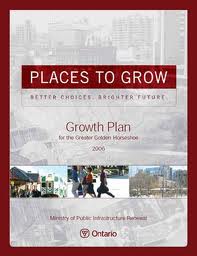
If we go back in time, it all started with the Provincial Places to Grow Act of 2005. This was the first attempt by the Province to control urban sprawl, preserve our Greenbelt for nature and agriculture and plan for better transit options in the Greater Toronto to Niagara area. The Growth Plan of 2006 followed, designating increased densities of population and jobs in most municipalities of Southern Ontario and calling these Urban Growth Centres.
Cities did have some say in these designations. For instance, Oakville decided not to intensify its downtown to Provincial targets, but rather to expand population and jobs dramatically around its GO Transit Station at Trafalgar Road. This would be its Urban Growth Centre. It would intensify its downtown using its own zoning rules in its Official Plan. It would intensify its downtown more gently than an Urban Growth Centre.
Burlington Council at the time appears to have bought into the idea of the Downtown Urban Growth Centre, as suggested by the Province. I can find no counter debate or decision to intensify around our GO Transit Stations instead of our downtown. This decision to go with the Provincial flow would lead nearly ten years later to where we are today – the rush to over-intensify the Brant Street corridor and nearby streets to the east and west under a new Official Plan.
Getting back to the past, Metrolinx was conceived in 2007, shortly after the Growth Plan was enacted. It was all about transportation across the regions to support intensified population and job centres.
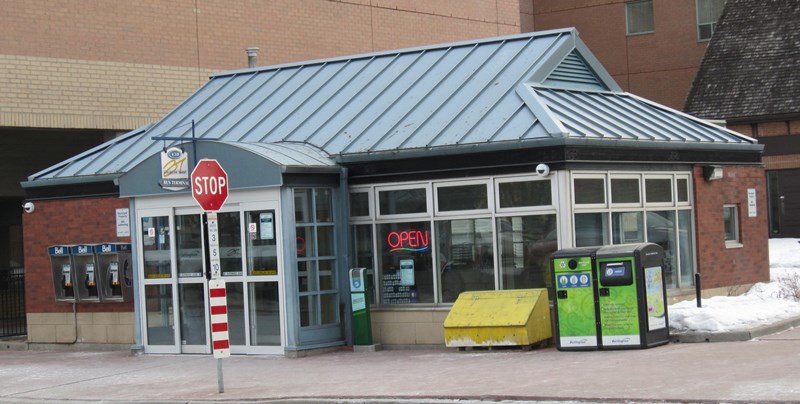
Less than three years ago the transit terminal was going to be torn down – now it appears to be the “anchor” for a mobility hub.
It focused on the GO Transit network of stations for the most part, but also added in subway, light rail transit and bus rapid transit routes, established and suggested for the future, as connecting links to GO Stations to move people in the this large region, mostly to and from jobs. Hence the Big Move nomenclature that was attached.
Soon the term Mobility Hub would be added to the vernacular in 2008. These were supposed to support Urban Growth Centres by linking them through the transit networks of municipalities and GO services. They were originally supposed to be locations where a number of modes of transportation came together as a network to facilitate the movement of people easily between these modes.

The Burlington GO station – an obvious location for a mobility hub.
GO Stations would all naturally qualify as Mobility Hubs because they link car, train, City and GO bus, bicycle and pedestrian modes of travel together in one place, with parking provided at no extra cost. Only recently have I seen the designation of Anchor Mobility Hub used to describe those Urban Growth Centre hubs that fail to qualify as true Mobility Hubs. The Burlington Downtown Mobility Hub is one of those Anchors. It has no trains, no light rail transit or rapid bus transit. And it has no free parking for cars.
It seems that Urban Growth Centres and Mobility Hubs have been linked together for quite a long time, dating back to 2008. This linkage is not accidental. It seems that to be an Urban Growth Centre, you had to have or plan for a Mobility Hub and vice versa.
These linkages were known to municipalities since 2008 and some decided, like Oakville, to chart their own course and preserve their downtowns from over-development by accepting the Urban Growth Centre/Mobility premise, but set in places best suited to dramatic infill of high rise condos and some retail and office space. GO Station locales were the obvious choice in this case.
In Burlington’s case, as stated before, it appears that no disagreement with the Province’s suggested choices for a downtown Urban Growth Centre/Mobility Hub ever arose in City Council meetings. The Province chose our downtown as both and our Council at the time (somewhere in 2008 – 2010) accepted, possibly without public debate. Council may have thought that the downtown needed improvement and this pathway, as mandated by the Province, was as good a way to get it done as any “made in Burlington” solution. And the Province could always be blamed if it didn’t work out quite right. I should note that one of our GO Stations, Burlington GO Station, was designated a Mobility Hub by Metrolinx (ie. the Province) and also accepted by Council.
There is a private, non-partisan charitable foundation known as the Neptis Foundation (www.neptis.org) that researches and reports on regional growth plans and initiatives. It has done some excellent reports on the Growth Plan and Urban Growth Centres that describe in layman’s language the Province’s plans and the repercussions to Ontario municipalities starting with 2006 people/job densities and projecting the changes required for 2031 densities. I would invite you to check out their reports.
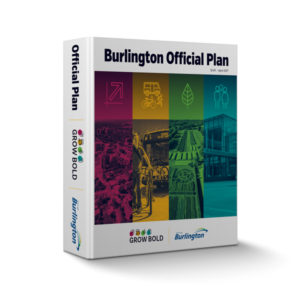
Many want the Mobility Hubs kept out of the Official Plan.
Some municipalities have integrated the Province’s growth plans into their Official Plans in major ways. Burlington is one of these municipalities. Other municipalities have done less or even no integration. There is no prize from the Province that I can detect for doing so, nor any penalty thus far for ignoring the Province.
The Ontario Government reviewed the 2006 Growth Plan in 2016 and reported in July 2017 a revised Growth Plan going all the way to 2041. It can be found at www.placestogrow.ca.
It should be noted that right from the beginning, expectations for each municipality were “directing growth to major transit station areas”, “identifies priority transit corridors”, “complete detailed planning for major transit station areas on these corridors to support planned service levels”, “plan for a range and mix of housing, including second units and affordable housing” and “accommodate a range of household sizes”.
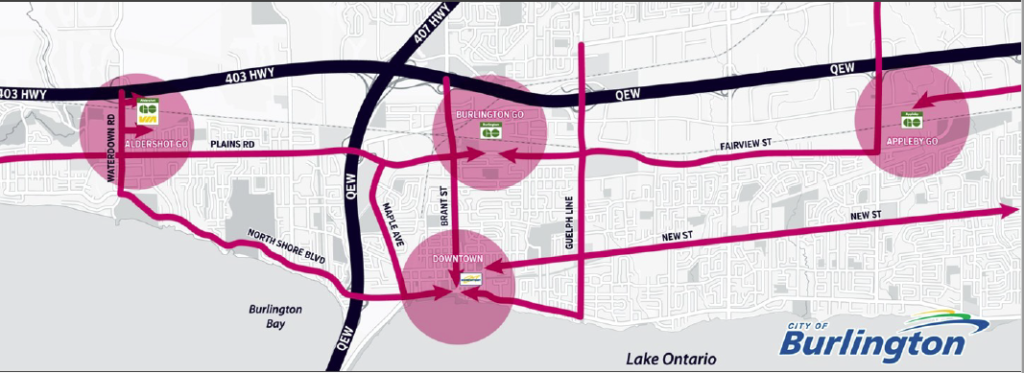
Having Mobility hubs at the GO stations is something everyone agrees on – it is the idea of a Mobility Hub in the downtown core that has many opposed.
How is Burlington doing in these initiatives? Well, all three GO Stations in the City have been named Mobility Hubs and each are planned to house many thousands of people/jobs by 2031. So growth is being directed to our major transit stations. Will there be any affordable housing and accommodation of a range of household sizes? That’s an unanswered question thus far.
I thought that Burlington was mandated to grow to a population of 215,000 by 2031. I have since been informed the target is 185,000 minimum. We are at 183,000 now. Recently at a Planning and Development Committee meeting, the Ward 1 Councillor stated publicly that Aldershot was set to grow by another 27,000 people by 2031. This would likely be near the Aldershot GO Station or along the Plains Road Corridor. Adding another 11,000 jobs there would bring the additional people/jobs total to 38,000 by 2031 and a 300 people/jobs per hectare goal, as per a Planning Department report dated Nov. 9, 2017.
Similarly, Planning Department reports also dated Nov. 9, 2017 for the other GO Stations show the Burlington GO Station Mobility Hub adding 22,000 new residents and 9,500 jobs by 2031 and the Appleby GO Station Mobility Hub adding 20,000 new residents and 43,000 new jobs by 2031. Both would also reach the 300 people/jobs per hectare goal.
All together, the three GO Station Mobility Hubs are planned to add 69,000 new residents to Burlington’s population by 2031, far exceeding any goal of 185,000 or even 215,000. We’re headed to a quarter million people by 2031, without touching the downtown.
So it is clear to me that we can reach all Provincial goals easily using intensification of people and jobs at the GO Station Mobility Hubs. There is no need to further intensify the downtown at all. It could be left to gently intensify, like Oakville has planned, using current Official Plan zoning rather than dramatically intensify as the Planning Department has advocated in its new Downtown Mobility Hub Plan and the new City Official Plan.
Anchor Mobility Hubs were originally expected to support an area with a minimum of 160 people/jobs per hectare within a 500 metre radius that would be serviced by a light rail transit or a bus rapid transit system.
The City is using a 200 people/jobs per hectare goal, which may be the revised mandate. I understand that City Planners and most of City Council are backing the people/jobs density downtown, but I see no evidence that there is an LRT or BRT system in place to deal with this influx of people/jobs, other than an LRT label being affixed to Brant Street on maps. A label isn’t a plan unfortunately.
I also see no evidence that jobs will flow into the downtown, even to just replace the ones lost when current buildings are demolished awaiting construction of new buildings. The podium style high rises with 3 to 4 storey glass and steel walls along Brant Street will replace individual and unique store frontages we have today. Is this better or worse at enticing jobs and vibrancy to Brant Street?
I am a person who believes that a deal is never a done deal if there is still an opportunity to question and possibly change people’s minds for the better of the community. And I think that we do have that opportunity.
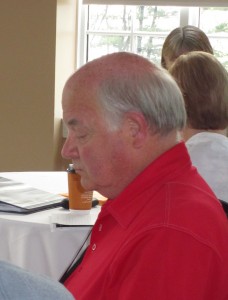
John Taylor, the Dean of city council would have been part of any debate there might have been about accepting the provincial approach to mobility hubs.
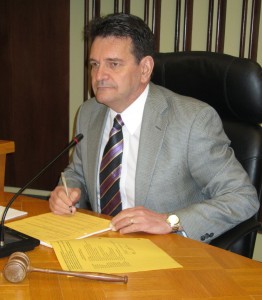
Ward 1 Councillor Rick Craven – a member of council in between 2008 and 2010 when Scobie believes city council made the decision to follow the provincial lead.
Four members of the current Council were members of Council when all these Provincial demands were rubber-stamped. I would ask them to search their memory banks and their notes and inform the public how they decided to acquiesce to the Province’s demands for intensifying our downtown, why they didn’t make the logical suggestion for intensification around GO Stations instead and if they did go ahead with the plans without public consultation.
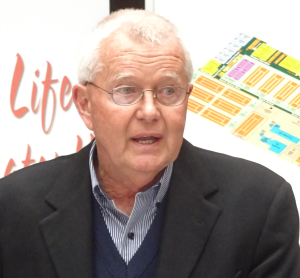
Jack Dennison, a member of city council for more than 20 years would remember how the decision to accept the provincial direction – somewhere between 2008 and 2010 was made.

Mayor Rick Goldring was a council member when the decision was made to accept the province’s approach to transportation hubs, possibly without public debate.
The current Council certainly did not acquiesce to the 374 Martha Street proposed high rise a few years ago. Yet this same Council voted 5 – 2 in favour of a 23 storey condo on November 30, 2017 across the road from our 8 storey signature City Hall – going past the 12 storey current storey zoning and even going past the recommended 17 storey zoning in a Downtown Mobility Hub Plan not yet approved.
This decision has ignited public opinion against the over-intensification of the downtown. They see high rises coming on many corners of Brant Street, and with many mid-rise condos in between. And they see many high buildings destined to come on nearby north-south streets east and west of Brant Street.
During the Vietnam War an infamous sentence was uttered by a field commander which showed the absurdity of war – “We had to destroy the village in order to save it”. Brant Street and our downtown does not need to be destroyed in order to save it.
Gently intensifying the downtown will continue as it has in the past, using appropriate zoning already in place. City planners and City Council need only enforce our current Official Plan and use the concepts already in place in our Tall Building Guidelines and soon to be in place in our Mid Rise Building Guidelines that the Planning Department has committed to.
Our downtown Bus Station is not a Mobility Hub and there is no plan to make it one. Our downtown does not need to be over-intensified through a designation as an Urban Growth Centre. I am asking City Council to inform the Province that Burlington can and will meet its 2031 growth target through dramatic intensification around our three GO Stations, the appropriate place for high rise condos with retail and office space.
That’s where the thousands of new residents will be housed, hopefully with a good number of affordable, family-sized units.
The downtown will intensify too, but not in the dramatic fashion envisioned by the Planning Department.
I am asking City Council to request that the terms Mobility Hub and Urban Growth Centre be removed from the Provincial Growth Plan for the Downtown Precincts and instead be placed on all three GO Stations.
Let our downtown, which admittedly does need to change, do so in a measured and controlled fashion that adheres to reasonable and defendable zoning restrictions already in place. Do not follow through on an Official Plan that would create the “Metropolis” of Halton in our downtown.
 Gary Scobie, a long time resident of Burlington is a frequent opinion contributor to the Gazette. He was a member of the Waterfront Advisory Committee and has been a strong advocate for maintaining public access to the waterfront.
Gary Scobie, a long time resident of Burlington is a frequent opinion contributor to the Gazette. He was a member of the Waterfront Advisory Committee and has been a strong advocate for maintaining public access to the waterfront.




















Thank you Gary, no hard feelings, I appreciate what you’re doing. I also wish you the best of luck in the downtown core – you’re going to need it. The battle’s already been lost out here in Aldershot. We were thrown under the bus of urban intensification long ago. Now it’s your turn.
When you stated “it is clear to me that we can reach all Provincial goals easily using intensification of people and jobs at the GO Station Mobility Hubs” the thing that rankled me is that you didn’t seem to consider the price other members of your community are paying to reach these nonsensical “goals”.
With elections looming in 2018 I think it’s high time the citizens of Burlington hit the brakes on the “Big Move”.
Thank you all for commenting. And I mean all, even those who disagree with some of my opinions or correct some of my figures and supply more information about this confusing subject. I appreciate all of it. I believe this issue of intensification that has been imposed by the Province on so many towns and cities, upsets people more than any other City of Burlington issue for the future.
The more we talk about it, the more people become informed. All this dialog is healthy and necessary. It shines a light on a subject that needs it. There are many sides to discuss and debate, so let’s keep doing so – here, on social media and at City Hall. Comment, write your own article, contact the Mayor and your Councillor, delegate on January 23rd to the Planning and Development Committee meeting. All views are welcome and valid. This is what democracy is supposed to look like.
Gary, as discussed, there is a lot of information to digest. My interest is primarily in the downtown, as my wife and I intend to move there (yes, into a condo) once our boomerang children finally leave the nest.
Prior to now, I have not looked too much into the other hubs, as our desire is to no longer be a commuter, which the GO hubs seem to cater to. However, in looking through the City’s reports I did pick up on an error regarding the vernacular regarding the numbers. The reports keep saying “new” people and “new” jobs. The calculations are for full build out, which would include any current people and jobs that remain or those that are replaced. This would mean that these are the potential total number of people and jobs for those hubs and not additional, as the “new” would imply.
To get the proper increase in population at these hubs, one would have to subtract the current numbers from the 69,000 per the reports. I only have the information from the Metrolinx hub profile for the Burlington GO, which I am cautiously using here, which indicates 3,600 people in 2015. If this is correct, the increase will still be significant, however it is an additional 18,400 people and not 22,000.
Keep in mind, these are full build outs, which are not expected to be attained for 40 to 50 years.
The reason I am cautious using this number is because the population density from this profile is calculated to be 18 people per Hectare, which indicates a 200 Hectare hub (the jobs per hectare also indicates this). The City’s report indicates the size of the hub as being 97 Hectares. So, if there is a discrepancy in size is there a discrepancy in the number of people and jobs?
To provide a further example of inaccuracy, for the Downtown Hub, the Metrolinx profile shows 7,800 people at a density of 52 people per hectare. This indicates a size of 150 Hectares. The jobs show 3,600 job at a density of 18.5, which would indicate 194.6 Hectares. Obviously, there is a miscalculation here.
Interesting to note that per the City’s analysis of the UGC the population is 9,217 and the number of jobs is 7,162. Much higher than those in the Metrolinx profile and over a smaller 104.6 Hectare area. How can there be more people and jobs in the UGC (fully contained in the hub) than the whole hub?
This again shows how the data that is out there may not be quite as it seems. The data should be researched and verified, otherwise we have a large group of misinformed people with no one truly knowing what is correct.
Brian, you seem to be very well informed. I’m guessing that you also have significant skin in the game. I think that your entire post can be distilled down to this statement: “It is unfortunate that our society is so dependent upon car travel. The Big Move recognizes this and is looking to a future reduction in that dependency and therefore reducing the carbon footprint.”
The “Big Move” is social engineering at its worst. It is a city-centric, utopian misfire that flies in the face of reality.
What has this vision achieved? Skyrocketing electricity rates. A complete distortion of the real estate market in the Golden Horseshoe as a growing population is shoehorned into a vanishingly small sliver of land. Billions in lost production as carnage and chaos and gridlock cripple the 400 series and QEW highways… if the citizens of Ontario were being killed and injured on public transit at the rate they are on our horrible road networks, there would have been a provincial coroner’s inquiry long ago.
You don’t need to tell me that “therefore, the driving of cars is at the lowest priority.” We’re stuck in the gridlock, we hear the sirens daily. Your “low priority” mindset is getting people killed.
The stated “hierarchy of modes of transit” also flies in the face of reality, but I think you know that. By the way, I think unicorns should be tied for number 1, along with Segways and monorails. Might as well swing for the fences since it’s all make believe anyway.
We get it. Cars are bad. Urban sprawl is bad. Owning a freehold home is bad. Successive McGuinty/Wynn governments gulped the kool aid on AGW and we’ve been paying the price in the form of disastrous public policy decisions ever since. Thank you Dalton, Kathleen and last but not least, the unelected Gerald Butts. June 7, 2018 can’t come soon enough.
I live relatively close to the Aldershot “Mobility Hub”. Kind of an oxymoronic term, but I’m sure it looks great on the PowerPoint displays. Thanks to fine folks like the Adi brothers, your plan will stuff a MINIMUM of 10,000 people within an 800 meter radius of the Aldershot GO station. And none of them will have cars!
Where will they work? Well right now, 800 meters from the GO will have you cracking rocks at King Paving or working the pole over at The Gold.
But even those jobs are already gone – the land’s far too valuable. Soon we’ll get to watch a few more large scale, out of town developers drop some high rises and million dollar townhouses on what’s left of our community. Why do I get the feeling that everyone has seen these plans except for the actual citizens of Aldershot?
When the dust settles the developers will have moved on with all of their loot and we’ll be left with the “Grey Zone”, a gridlocked commuter corridor lined with ugly condo buildings squatting over a myriad of nail salons.
I remember taking my very young children to watch the Drewlo highrises squash our grocery store/bank/liquor store/department store/barber shop. They liked the “mighty machines.” It warms my heart to know that somewhere in Aldershot they’ll be able to continue the tradition with their own children 15 years from now.
“Urban intensification” is the election issue of 2018. If our elected officials aren’t aware of the simmering resentment that is bubbling up in our communities, they will be come election day. Good luck to everyone.
Obviously, there is a lot of information to digest when it comes to understanding planning, especially when it comes Official Plans and Zoning By-Laws. Urban Growth Centres (UGC) and Mobility Hubs are just a couple of the many pieces of the puzzles, albeit perhaps the most important pieces. Based on this article, and many before it, citizens feel like they are getting slammed with this information, and it is overwhelming. I don’t think anyone can argue against that, however understand that much of this information is available online and has been there since the Places to Grow Act was implemented in 2006. Some even before that.
There should be a concern about the information that is being put out there, as it seems that there is a lot of misinformation in what I have read or seen, even some hyperbole either intended or not.
Mr. Scobie’s article does provide some objective information about the UGC and Mobility Hubs, however there are some points that he has made where the information for UGCs is used for Mobility Hubs or where the perspective given is somewhat subjective.
Mobility Hubs appear to be the biggest concern for most. It is somewhat of a new “catchphrase” being used with little understanding or a misunderstanding of their purpose, and of what qualifies as a Mobility Hub.
Based on the glossary from the Big Move, here are some basic definitions regarding Mobility Hubs;
Mobility Hubs are basically “Major transit station areas, as defined in the Growth Plan for the Greater Golden Horseshoe, that are particularly significant given the level of transit service that is planned for them and the development potential around them.”. Not only does it have to do with planned or forecasted boardings and alightings it also has to do with the potential to achieve a minimum density of 10,000 people and jobs within 800 metres of the major transit station. The primary major transit station area associated with an UGC is also identified as a Mobility Hub.
A Major Transit Station Area is “The area including and around any existing or planned higher-order transit station within a settlement area, or the area including and around a major bus depot in an urban core.”. Some may question the downtown bus station as qualifying, however it does currently service several Burlington Transit routes as well as Greyhound. It is also shown in the Big Move to have a future LRT line connecting to the Burlington GO station.
Anchor Hubs are “Mobility hubs that have strategic importance due to their relationship with urban growth centres (UGCs), as well as Pearson Airport and Union Station due to their roles as the GTHA’s primary international gateways.”. Where UGCs are “identified in the Growth Plan for the Greater Golden Horseshoe as focal areas for directing significant high-density employment and population growth, major transit infrastructure, and a mix of land uses such as commercial, recreational, cultural, entertainment, institutional and public services. As such, they contain current or planned major regional destinations such as major institutions, employment centres, town centres or regional shopping centres, and they have significant potential to attract and accommodate new growth and development.” Anchor Hubs “have the potential to transform the regional urban structure and act as anchors of the regional transportation system.”. Where Downtown Burlington was designated as an UGC and it has a Major Transit Station Area within, it qualifies as an Anchor Hub and has been designated as such in the Big Move.
Gateway Hubs are “All mobility hubs that are not Anchor Hubs.”. Based on this, it appears that the most important Mobility Hubs (even by their name) are the Anchor Hubs. If it can’t be an Anchor Hub it has to be a Gateway Hub. Thus the Downtown Burlington Anchor Mobility Hub is the primary Mobility Hub in Burlington and this is where the most focus should be made.
There is a perception that a Mobility Hub is a station where a variety of modes of transport converge, most specifically where cars can be driven to subway or rail stations. However, the station in itself is not the Mobility Hub. It is the center around which the Mobility Hub is to be planned.
It is also important to note that the hierarchy of modes of transit are;
(1) Walking
(2) Cycling
(3) Transit
(4) Ride-sharing and taxis
(5) Single-occupant vehicles
Therefore, the driving of cars is the at the lowest priority. This is because the intent of the Big Move and Mobility Hubs is to provide more readily accessible public transit option while reducing the dependency on cars. It is not just about getting to and from the station, as it is also about modes of transit within the Mobility Hub to Shop, Dine, Work and Live. It is unfortunate that our society is so dependent upon car travel. The Big Move recognizes this and is looking to a future reduction in that dependency and therefore reducing the carbon footprint.
The provincially deemed Mobility Hubs, based on the definitions and projections are the Downtown Anchor Mobility Hub and the Burlington GO Gateway Mobility Hub. The Mobility Hubs at the Aldershot and Appleby Go stations are designated by the City, most likely in recognition of being areas feasible for planning for intensification, as Burlington has run out greenfield for growth. The other areas also being recognized as being suitable for growth are the transit corridors that connect the hubs. The hubs and these corridors make up most of the 5% of Burlington that has been allotted for growth.
Mr. Scobie mentions that the Downtown Hub does not have trains or rapid transit, nor does it provide free parking. The Big Move does include plans for a rapid transit route connecting Fairview to the downtown in its 15-year plan. Over time the intent is to also have a single fee transit system that allows for seamless transfer from local to regional to local systems. Once these are in place, you will see the move the charge for parking at the GO stations as the intent is to reduce dependency on car use. Free parking downtown would encourage more people to drive downtown. Are not people commenting already about traffic downtown? Would not free parking add to that? Free parking at the fringes with a proper transit system to shuttle people into the core would be far better.
As far as the densities for the Mobility Hubs, the goal is for them, per the Big Move, is to be within a range, which is 150 to 300 people and jobs per Hectare. Mr. Scobie makes reference the 200 people and jobs per Hectare goal, implying some sort of a revised mandate. The fact is that the 200 people and jobs per Hectare is a minimum requirement for the UGC, not the Mobility Hub.
It appears that what is lost in all the Mobility Hub talk is that it actually is the UGC where the requirements for growth stem from. Downtown Burlington has been an UGC for 11 years. It was 117 Hectares in size in 2006. Sometime in 2008 it was proposed to have its boundaries changed where it appears to have incorporated in the Regions plans in 2015 as being 104.6 Hectares. Some of the boundary changes make no sense, however that is a discussion for another time.
The Mobility Hub guidelines come into play more in assisting in determining where the growth or density for the UGC should be concentrated. The primary area, within 250 metres of the bus station should be high density of mixed use. In the secondary zone, 250 metres to 500 metres, the density should remain high with the mixed use being less commercial. The tertiary zone extends out to the 800 metre point and is to be the transition zone to the established neighborhoods.
Interestingly, the downtown hub extends up Brant to Prospect, being 1,300 metres from the bus station. That edge is in fact closer to the Burlington GO hub, at 1,100 metres. The section from Baldwin/Victoria to Prospect is part of the catchment areas of both hubs and it should actually be part of the transit corridor connecting the hubs. Here is a question, how do the residents in the area feel about how the buildings with the most height have been pushed up into their area? Is it not a fairly narrow neck with little buffer to tall buildings? Impacts will be much greater here to residents than to anyone in the downtown near the station.
Mr. Scobie also indicates that “There is no prize … nor any penalty …” for meeting the goals or not. Although not clearly in black or white, section 7 of Big Move does imply that size of the transit funding pie that is available to the City is determined by how the goals are met. With the recent acknowledgement that the Burlington Transit is hurting, meeting the goals has a two-edged sword;
1) It appears funding might be readily available for improving/updating the system.
2)Increased people and jobs increases ridership and increases to the tax base.
One final note is that it is mandated that new Official Plans must incorporate UGCs and Mobility Hubs. Keep in mind that any planning is focused on the future. Just look at how the words planned, forecasted or potential are used within the Big Move or Places to Grow. It seems to me that all the councilors have some understanding of this, except one.
Brian: As to your comment about the fact that Mr. Scobie “makes reference the 200 people and jobs per Hectare goal, implying some sort of a revised mandate. The fact is that the 200 people and jobs per Hectare is a minimum requirement for the UGC, not the Mobility Hub.”
If we are intent on drilling down and trying to make sense of the myriad of documents and government policy, we would need an army of analysts to sort the wheat from the chaff. The Burlington Mobility Hub Study states, “The Downtown Burlington Mobility Hub is a provincially and locally recognized Mobility Hub centred around the John Street Bus Terminal. The Downtown Mobility Hub study area boundary is comprised of a combination of the Urban Growth Centre and Official Plan precinct boundaries.” The Growth Plan for the Greater Golden Horseshoe, 2017 on the other hand refers to the “200 residents and jobs combined per hectare for Downtown Burlington” and growth centres, making them one and the same.
We can slice and dice this until the cows come home but the result is the same. We are arguing semantics, when the real issue is council voted against its current and revised official plans.
“As in the pseudoscience of bloodletting, just so in the pseudoscience of city rebuilding and planning, years of learning and a plethora of subtle and complicated dogma have arisen on a foundation of nonsense.”
Now that is a layman’s description of what is the “absolute truth” as to what the downtown should be, and how the City Father’s sit and think we are all morons! They just go with what is presented to them, and move it forward as quickly as possible. Those in Council and the Planning Dept. that are there “just for a pay cheque” and really have no interest in the future of downtown Burlington, should move on! I think you, Mr. Scobie should make your way into the oval City Chambers into one of the chairs that “will make a difference”. You see the picture as it should be, and are excellent in explaining what is so clear to us all. What is wrong with the thinking of those we have elected to be making these plain and simple decisions for the betterment of the downtown???????????????????????They are losing nothing with intensification strategically placed where it should be (near the GO Station Mobility Hubs), not the (Anchor Station downtown).
Thanks for the analysis Gary, it’s much appreciated. Greetings from the “Grey Zone”, formerly known as Aldershot. You remember… Aldershot, the small community that has been doing the heavy lifting for +15 years in this disastrously misguided attempt at “urban intensification”.
Please take anything Councillor Craven says with a huge grain of salt. If he tells you the sky is blue, double check, just to be safe.
11,000 new jobs in Aldershot? 11,000 jobs. Does that number make any sense to you? That’s a sh*t ton of nail salons Gary.
27,000 new residents? Where? The Grey Zone’s already looking like a concrete rabbit warren. Sadly, this number may be accurate. Our friendly, altruistic developers can cram a lot of 600 square foot squirrel cage condos in and around those railway tracks. They want what’s best for Aldershot too!
It is particularly galling to me that we are trying to achieve growth numbers set down by a provincial government that lacks the competence to manage an energy grid or even issue an electronic health card to its citizens.
The ongoing urban intensification of Burlington is THE election issue of 2018. If council wants to continue this madness they need to seek a mandate from the voting public. And this time, present a viable long range plan, not one with unicorns riding around on monorails.
Out here in the Grey Zone, people are getting really fed up. I certainly don’t have the stomach to put up with another 15 years of urban infilling and construction. Our community is being ruined by this nonsense and it has to stop.
I look forward to the coming election but the damage to downtown will already be done if the OP is approved before the election. The OP MUST be done after the election!
The current Council members (ex one) have neither a conscience nor a backbone.
Great Job Gary. The run-away freight train called Mobility Hubs is out of control. One writer keeps harping about the non-fact that, “the downtown core needs a makeover the store fronts are far from quaint and business seems lacking for retailers today such that stores/restaurants either are closing or moving to more populated parts of Burlington so they can survive”.
One reason we won’t ever see gentrification in our downtown, is developers have mostly assembled our downtown, and would sooner level the place. Their goal, replace our downtown with tall podium type buildings made of steel and glass that have next to zero architectural longevity. If council had the internal fortitude to walk away from this awful plan, the assembled properties would be dumped in a nanosecond.
Bravo!Bravo!Bravo!
Evident that council is hiding behind the Province…but as you indicate…no slap on the wrist..if we tread cautiously like Oakville.
Now, let’s hear council reply to Gary’s analysis.
Thank you for this thorough analysis Gary! I look forward to pasting the link when I am trying to explain this to someone who accuses us of NIMBYism and a fear of tall buildings, or suggests that everything was approved years ago, so too late to worry about it now.
The councillors and mayor who were here at the time have some questions to answer. Sharman’s explanation for why he voted for the 23 storey building certainly doesn’t cut it.
Your final two paragraphs, with your official Ask of City Council to request that Mobility Hub and Urban Growth Centre be removed from the Provincial Growth Plan for the downtown should be asked by all of us, ASAP. I would suggest a petition, but we know how those are received by some on council …
I am not sure of the definition of over-intensification, but I think the downtown core needs a makeover the store fronts are far from quaint and business seems lacking for retailers today sucjh that stores/restaurants either are closing or moving to more populated parts of Burlington so they can survive. To me this means status quo is not acceptable in the long term we need more people such that more retail will come and survive. Currently the only time I see what I would call a vibrant Brant street is when we have a festival on at spencer smith other wise feels very empty. So I am in favour of huge scale change to the store fronts on Brant and a revitalization of village square seems like not much retail there accept restaurants similar to downtown in general.
So I agree with you Gary except the is concept of using the “mobility hubs” for “dramatic intensification around our three GO Stations”. Already 30,000 people are talked about around Aldershot station – with as far as I can see no amenities that would preserve the standard of living in it. We need to plan growth carefully at all locations. There is no actual rush and the “provincial mandate” has no time before 2031 – lots of time.
“Having Mobility hubs at the GO stations is something everyone agrees on”
I’m not sure what “mobility hub” means anymore, but the concept is getting worse by the day. Piling in 22 story buildings with 400 square foot apartments and again – nothing else defined I can see. Seems a setup for a possible future slum of staggering depth and size. The high density migrant worker camp “mobility hub” vision I certainly oppose.
By leaving it as a hub our councillors quietly by omission have let Brant Street be open season for developers. One little bus terminal serving Burlington Transit is hardly a transportation hub! Remember that this year, Burlington Council did not approve of the abolishment of the OMB. Fortunately, Oakville and a majority of other municipalities did.
Do I sense a developer friendly council? Election day can’t come soon enough.
Excellent analysis of the current situation Gary. Hopefully council members read this article and act in the best interests of the citizens of Burlington.
Great analysis Gary. Thank you for your insightful and thought provoking assessment!
If Burlington is well on its way to achieving intensification targets why the push on for greater development downtown? If the downtown terminal lacks the various modes for transportation then how can it be a Mobility Hub? And if there is no new transportation mechanism to bring people downtown via public transit, and no new upgrades to the transportation network, then what additional pressures and challenges does this present for residents and downtown businesses?
Seems to me the four Council members, including our Mayor, have some questions to answer. Should make for an interesting municipal election. On the other hand, might also be a good time to decide not to seek re-election.
Bravo Gary! Brilliant analysis that does put the growth plan in perspective. The expected growth in the mobility hubs, pushing the population to a quarter million is stunning.
My fear with city hall is these facts don’t matter.
We have a city manager who is bringing his North Vancouver experience and consultants to impose the Vancouverism model on Burlington.
We have planning staff enchanted with the tall buildings on a podium planning fad and have a professional interest in trying it out in Burlington.
We have developers who have assembled land in the downtown, who are ready to make a windfall once the new OP goes through.
We have city manager and deputy city manager, with a shaky grasp of land economics, who believe part of their mandate is to increase the profit margins of developers.
We have a planning department who believes their plan for the downtown is sound; the problem is only that they have to “clear up some of the misinformation that is out there when it comes to how Burlington will grow…to help [us] to make sense of some of that information and explain the facts.”